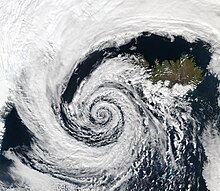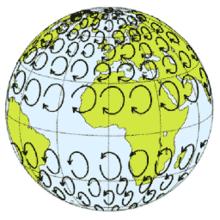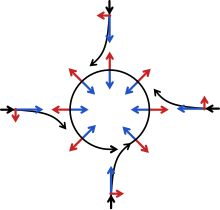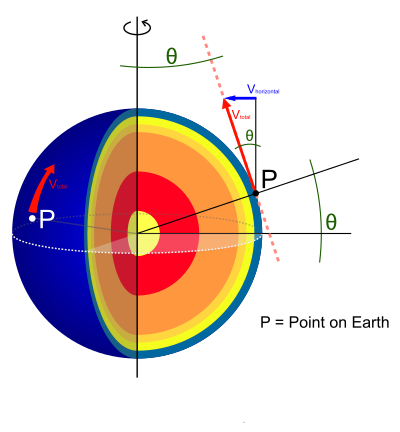Planet Earth/1g. Coriolis Effect: How Earth’s Spin Affects Motion Across its Surface
Earth’s Inertia
[edit | edit source]
As a spinning spheroid, Earth is constantly in motion, however one of the reasons you do not notice this spinning motion is because the Earth’s spin lacks any acceleration, and has a set speed or velocity. To offer an example that might be more familiar, imagine that Earth is a long train traveling at a constant speed down a very smooth track. The people on the train do not feel the motion. In fact, the passengers may be unaware of the motion of the train when the windows are closed and they do not have any reference to their motion from the surrounding passing landscape. If you were to drop a ball on the train it will fall straight downward from your perspective, and give the illusion that the train is not moving. This is because the train is traveling at a constant velocity, and hence has zero acceleration. If the train were to slow down, or speed up, the acceleration would change from zero, and the passengers would suddenly feel the motion of the train. If the train speeds up, and exhibits a positive acceleration, the passengers would feel a force pushing them backward. If the train slows down, and exhibits a negative acceleration, the passengers would feel a force pushing them forward. A ball dropped during these times would move in relationship to the slowing or increasing speed of the train. When the train is moving with constant velocity and zero acceleration we refer to this motion as inertia. An object with inertia has zero acceleration and a constant velocity or speed. Although the Earth’s spinning is slowing very very slightly, its acceleration is close to zero, and is in a state of inertia. As passengers on its surface we do not feel this motion because Earth’s spin is not speeding up or slowing down.

Differences in Velocity due to Earth’s Spheroid Shape
[edit | edit source]
The Earth is spherical in shape, represented by a globe. Because of this shape, free moving objects that move across the Earth’s surface long distances will experience differences in their velocity due to Earth’s curvature. Objects starting near the equator and moving toward the pole will have a faster starting velocity, because they are starting at the widest part of the Earth, and slow down as they move toward the poles. Likewise, objects starting near the poles and move toward the equator will increase their velocity, as they move toward the widest part of the Earth’s spin. These actions result in accelerations that are not zero, but positive and negative.

As a consequence, the path of free moving objects across large distances of the spinning surface of Earth curve. This effect on the object’s path is called the Coriolis Effect. Understanding the Coriolis effect is important to understand the motion of storms, hurricanes, ocean surface currents, as well as airplane flight paths, weather balloons, rockets and even long-distance rifle shooting. Anything that moves across different latitudes of the Earth will be subjected to the Coriolis effect.
Tossing a Ball on a Merry-go-round
[edit | edit source]
The best way to understand the Coriolis effect is to imagine a merry-go-round, which represents a single hemisphere of a spinning Earth. The merry-go-round has two people, Sally who is sitting on the edge of the spinning merry-go-round (representing a position on the Equator of the Earth), and George who is sitting at the center of the merry-go-round (representing a position on the North Pole of the Earth). George at the North Pole has a ball. He rolls the ball to Sally at the Equator. Because Sally has a faster velocity as she is sitting on the edge of the merry-go-round, by the time that the ball arrives at Sally’s position she will have moved left, and the ball rolled straight would miss her location. The ball’s path is straight from perspective above the merry-go-round, but from the perspective of George it appears that the ball’s path is moving toward the right of Sally. The key to understand this effect, is that the velocity of the ball increases as it moves from George to Sally, hence its acceleration is positive, while both George and Sally have zero acceleration. If we were to map the path of the rolled ball from the perspective of the merry-go-round, the path of the ball will curve clock-wise. Since the Earth is like a giant merry-go-round, we tend to view this change to the path of free moving objects as a Coriolis force. This force can be seen in the path of any free moving object that is moving across different latitudes. The coriolis force adheres to three rules.
The Rules of Earth’s Coriolis Force
[edit | edit source]- The Coriolis force is proportional to the velocity of the object relative to the Earth; if there is no relative velocity, there is no Coriolis force.
- The Coriolis force increases with increasing latitude; it is at a maximum at the North and South Poles, but with opposite signs, and is zero at the equator in respect to the mapped surface of the Earth, but does exert some upward force at the equator.
- The Coriolis force always acts at right angles to the direction of motion, in the Northern Hemisphere it acts to the right of the starting observation point, and in the Southern Hemisphere to the left of the starting observation point. This results in Clockwise motion in the Northern Hemisphere and Counter-Clockwise motion in the Southern Hemisphere.

These paths are difficult to empirically predict, as they appear to curve in respect to the surface of the Earth. One example where the Coriolis force comes into your daily life is when you travel by airplane crossing different latitudes. Because the Earth is moving below the airplane as it flies, the path relative to the Earth will curve, resulting in the airplane having to adjust its flight path to account for the motion of the Earth below. The Coriolis force also affects the atmosphere and ocean waters because these gasses and liquids are able to move in respect to the solid spinning Earth.
How to calculate the coriolis effect for a moving object across Earth’s surface. The red line is an object on earth traveling from point P at the velocity (V_total). For the coriolis effect only the horizontal speed (V_horizontal) is of importance. To get from one can say:
The coriolis force is then calculated by taking:
where is velocity of the Earth’s spin at the Equator, and m is the mass of the object.
A Common Misconception Regarding Flushing Toilets in Each Hemisphere
[edit | edit source]
A common misconception is that because of the Coriolis effect there were differences in the direction of the swirl of draining water from sinks, toilets and basins depending on the hemisphere. This misconception arose from a famous experiment that was conducted over a hundred years ago, where water was drained from a very large wooden barrel. After the water was allowed to sit and settle for a week (so that there was no influence of any agitation in the water). A tiny plug at the base on the barrel was pulled, and the water slowly drained out of the barrel. Because of the large size of the barrel, the water moved with different velocities across the breath of the barrel. Water on the equator side of the barrel move slightly further than the water on the pole side of the barrel resulting in a path toward the right in the Northern Hemisphere, resulting in a counter-clockwise direction of the draining water.
Since this famous experiment, popular accounts of the Coriolis effect have focused on this phenomenon, despite the fact that most drains are influenced more by the shape of the basin and flow of water. Rarely do they reflect the original experimental conditions of a large basin or barrel, and water that is perfectly settled in the basin. Recently the experiment has been replicated with small child swimming pools, (see https://www.youtube.com/watch?v=mXaad0rsV38) about several feet across. Even at this small size, it was found that the water drained counter-clock-wise in the Northern Hemisphere, and clock-wise in the Southern Hemisphere. Note that the effect will be more pronounced the closer the experiment is conducted near the poles.
Why the Swirl is in the Opposite Direction to the Movement?
[edit | edit source]
Why does the water swirl through the drain opposite to the direction of movement of the water? The motion of the water is relative to the drain plug, since the path from the equatorial side will be moving faster than at the center drain plug, the path will curve right in the Northern Hemisphere, resulting in a path that overshoots the center drain plug on the right side, from this point near the drain plug, the water will be pulled by gravity to flow through the drain toward the water’s left side resulting in a counter-clock-wise direction as it drains. In the Southern Hemisphere it will be in the opposite direction.

Satellites that track hurricanes and typhoons demonstrate that storms will curve to the right in the Northern Hemisphere and left in the Southern Hemisphere, but the clouds and winds will swirl in the opposite direction into the eye of the storm in a counter-clock-wise direction in the Northern Hemisphere and clock-wise direction in the Southern Hemisphere—similar to experiments with large barrels and child-size swimming pools. However, the storm’s overall path will be in a clock-wise direction in the Northern Hemisphere and counter-clock-wise direction in the Southern Hemisphere. This is why hurricanes hit the eastern coast and Gulf of Mexico in North America. Including the states of Florida, Louisiana, Texas, the Carolinas, Georgia and Virginia, and rarely if ever the western coast, such as California and the Baja California Peninsula of Mexico.
The Trajectory of Moving Objects on Earth’s Surface
[edit | edit source]If the trajectory of the free moving object does not cross different latitudes the path will be straight, since velocity in relationship to the Earth’s surface will remain the same, and acceleration will be zero. Coriolis effect behaves in three dimensions and the higher the altitude the more velocity will be exerted on the object. This is because the object’s position higher in the sky will result in a longer orbit around the Earth, and quicker velocity. Thus, changes in velocity can occur at any latitude if the free moving object changes altitude, and at the equator this force is vertical, leading to a peculiar net flow upward of air around the equator of the Earth, which is called the Intertropical Convergence Zone.
| Previous | Current | Next | |
|---|---|---|---|
|
g. Coriolis Effect: How Earth’s Spin Affects Motion Across its Surface. |
h. Milankovitch cycles: Oscillations in Earth’s Spin and Rotation. |





